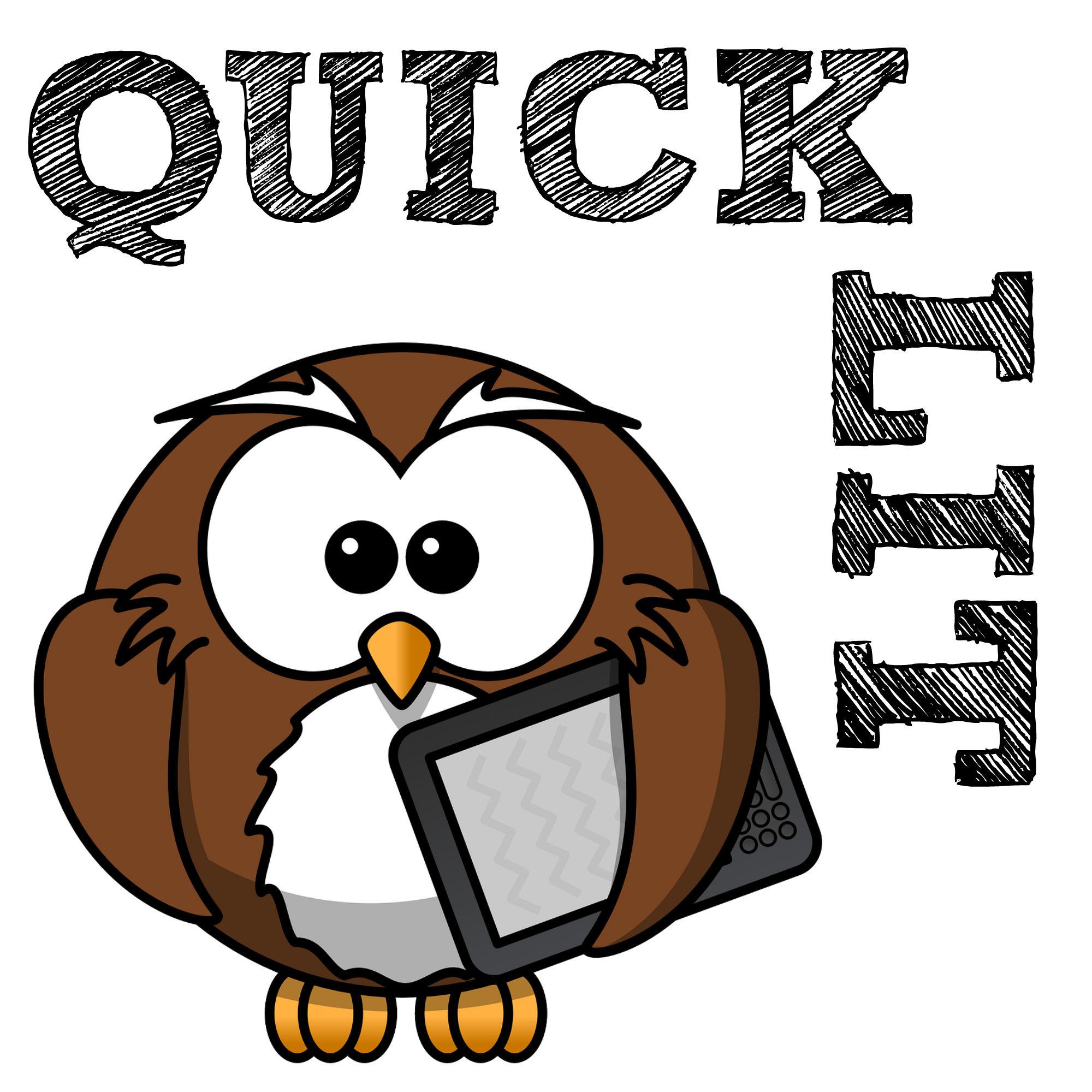It was an eclectic reading month, with quite a bit of Middle Grade, a few holiday books, a touch of fiction, and some really good nonfiction. Let’s get to the reviews!
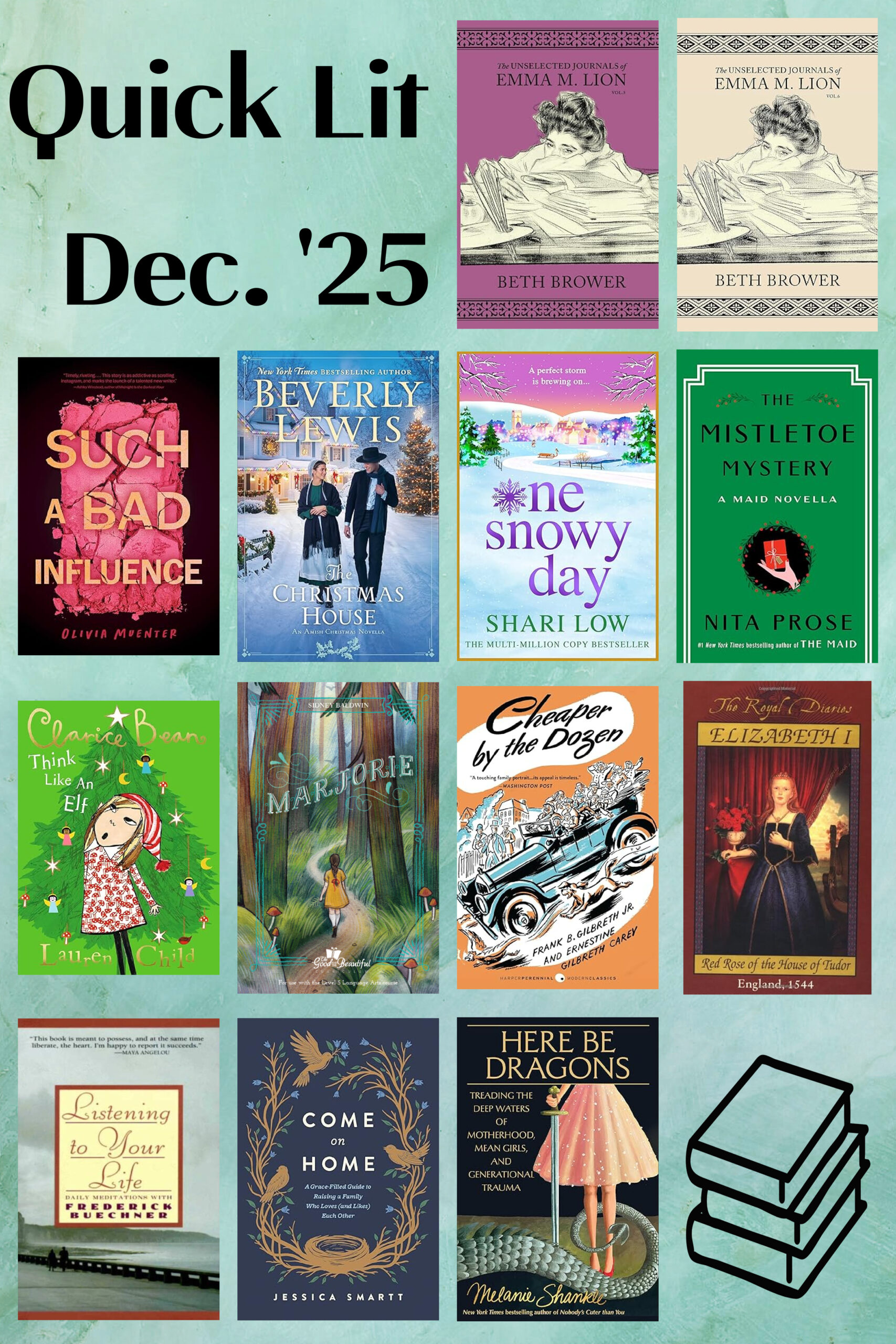
FICTION
The Unselected Journals of Emma M. Lion, Volume 5, by Beth Brower—The saga of our favorite Victorian heroine continues in this fifth volume that chronicles Emma’s November and December months. My timing with this one was accidental yet impeccable; the book was just what I needed as my first holiday read of the season. (But don’t worry, it isn’t so Christmas-themed that it would feel out of place if one were to read it outside of the Christmas months. Definitely read this series in order, regardless of whether or not your reading time frame lines up with Emma’s!)
Though dotted with moments of cheer and plenty of Emma’s unique brand of humor, the tone of this one is slightly darker as Emma works through heavy grief regarding some significant losses from her past. I appreciated Brower’s ability to realistically engage Emma’s sadness without weighing down this series that still feels light and fun. I loved watching Emma’s various relationships grow here as our side characters are given even more dimension.
Onward to volume 6!
My Rating: 4.5 Stars (Rounded to 4 Stars on Goodreads) // Book Format: Audiobook
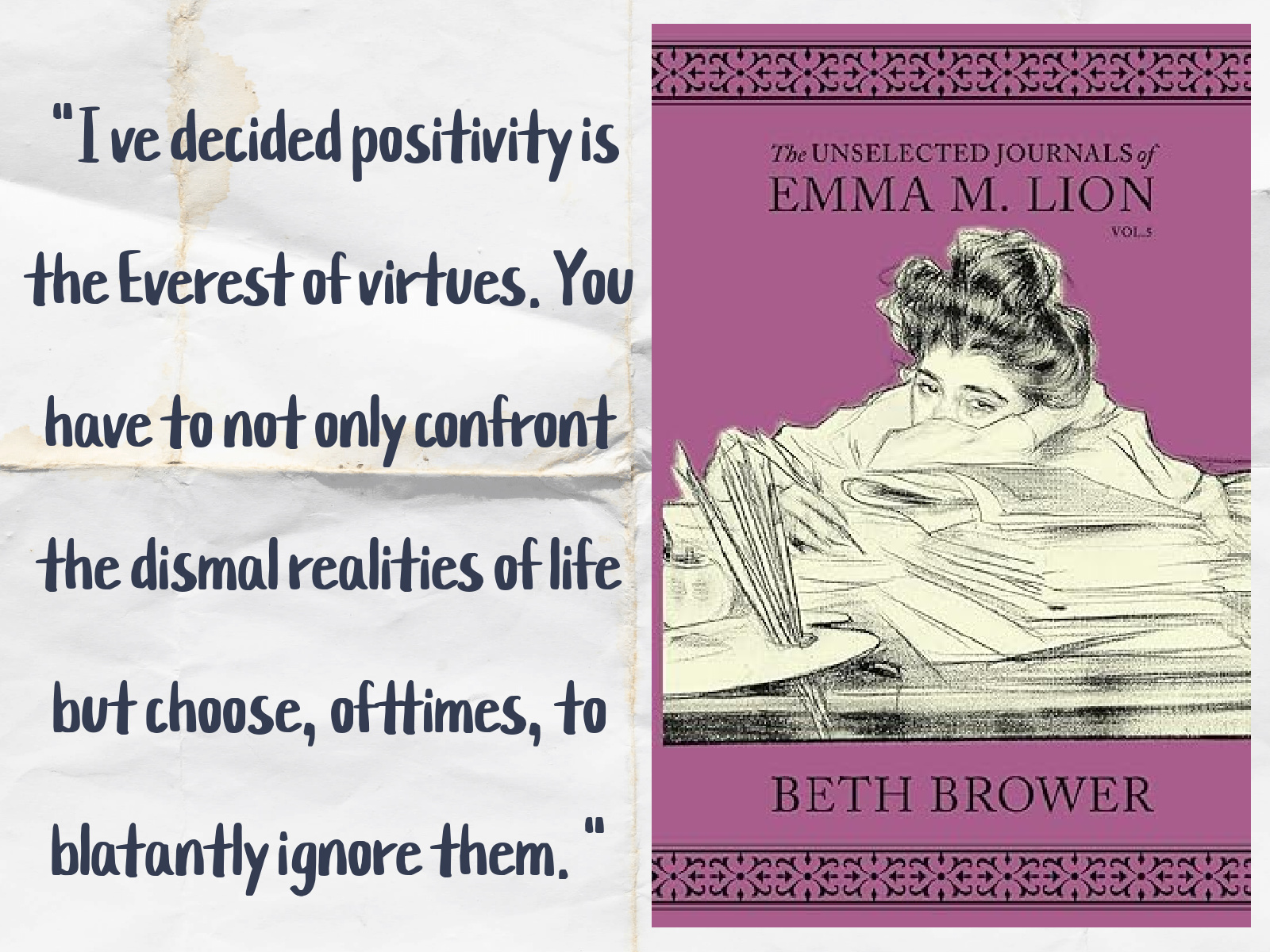
The Unselected Journals of Emma M. Lion, Volume 6, by Beth Brower—I suppose that there has to be a least favorite of every series, and this one fills that spot for me at this point in my foray through Emma’s journals. The humor and warmth are still here, but the story is unfolding a little more slowly at this point, and I think I wanted more action. . . which does come at the end, but I’m not totally sure how I feel about this turn of events! (No spoilers, but if you’ve read this you know what I’m referring to. Are you on board?!) Nevertheless, this is still a solid four stars, and I remain eager to continue the series. With this book, I enjoyed getting more backstory for the various men in Emma’s life, and it was nice to see her in a happier mental place after the emotional lows of the previous two installments.
Something I haven’t mentioned much (if at all) in my reviews of this series is Emma’s passion for reading, and we get quite a bit of her literary reflections with this volume. It’s wonderful to see Emma take such delight in books; perhaps it is (at least partially) to explain for the kinship so many of her fans feel with this gem of a character.
My Rating: 4 Stars // Book Format: Audiobook
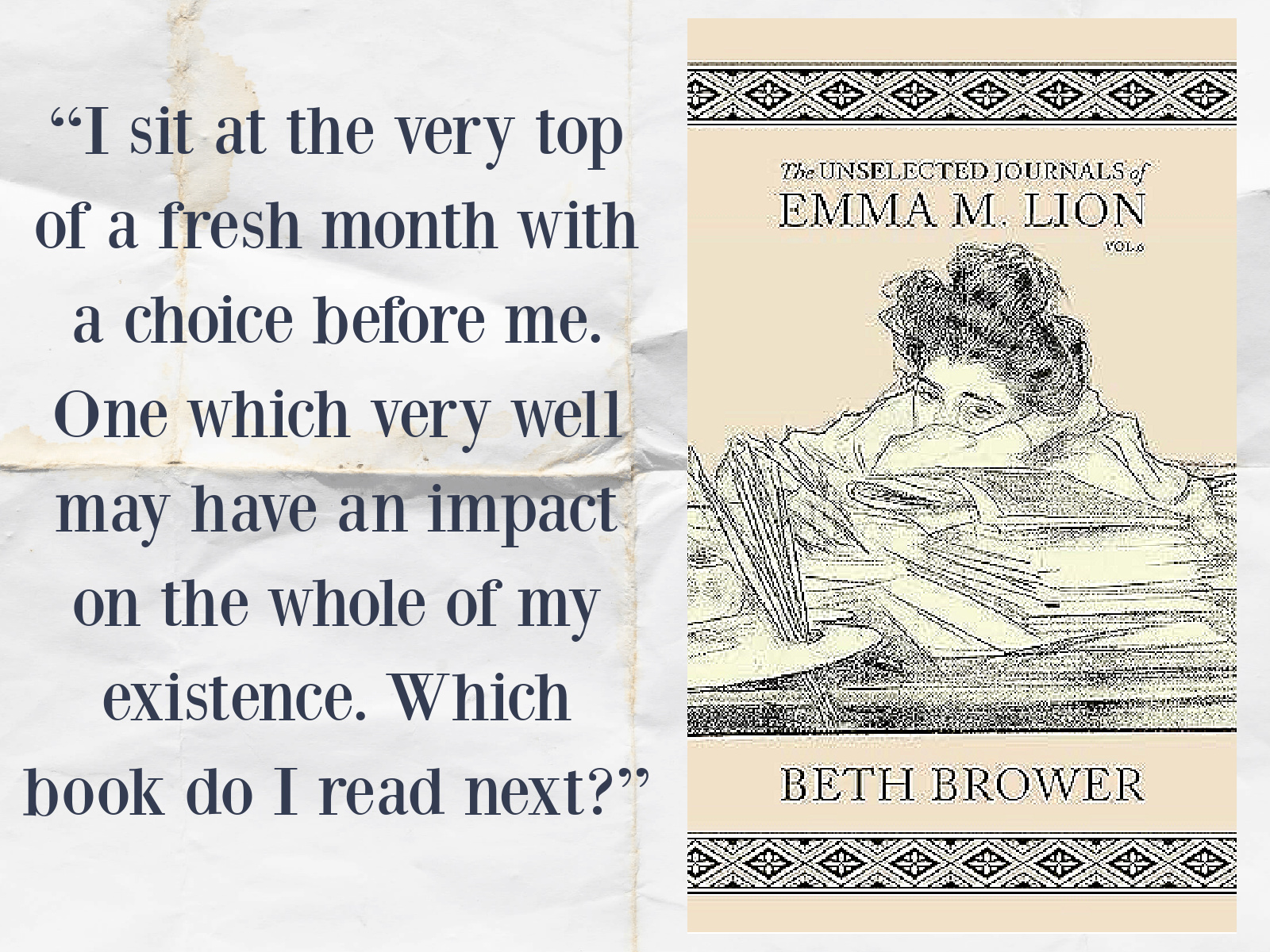
Such a Bad Influence, by Olivia Muenter—Hazel spent her childhood in the limelight as the daughter of an early YouTube adopter who was always creating content that she hoped would launch her into fame. That opportunity finally came when Hazel was in her teens and a family tragedy made Hazel’s younger sister, Evie, an instant star. Now Evie is 18 and an influencer with a multimillion-dollar career (all carefully managed by Evie’s image-obsessed, money-hungry mother). Hazel wants nothing to do with the family business, but when Evie goes missing without a trace, Hazel is forced to join forces with her estranged mother to determine the truth behind Evie’s disappearance. The investigation takes Hazel into the darkest corners of her family life, her sister’s questionable social circles, and the underbelly of influencer culture as Hazel learns more than she ever wanted to know about the sister she’s always loved but maybe never really knew.
Though billed as a psychological thriller, the mystery here is pretty thin, overshadowed by a complicated family saga and deep-dive into all things social media. While the main story (too drawn out) and the characters (unlikable) leave quite a bit to be desired, the book provides a provocative window into the world of an influencer, with Evie’s experiences—combined with other mixed media including podcast interviews, blog posts, and Reddit threads—exposing the hidden and unsavory parts of social media, particularly its exploitation of children. The book provides plenty of food for thought regarding the ways that we willingly engage in social media, propping up influencers as celebrities, then eagerly tearing them down. It looks at the duplicity of influencer culture, the harm that is done to the influencers AND those being influenced, the various ways that “mean girls” can emerge (both online and in real life), the many hidden hypocrisies of internet life, and the uncomfortably fine line between healthy internet engagement and voyeurism.
In addition to being an influencer exposé of sorts, this story also serves as a harsh critique of the commodification of children that is so prevalent among today’s parents (even those of us who are not Professional Influencers) and the toxicity that can creep into family dynamics when money and fame enter the picture. We also get a peek into the the worlds of ghostwriting, cults, and more. It’s a lot for one novel, and it’s pretty messy (no surprises giving the messy nature of each of these subjects!). A lot of this commentary lacks any hint of subtlety, which distracts from what might have been a compelling novel; I wouldn’t say that this was an especially enjoyable read, but I did like the shock ending, and there’s no denying that this story and its telling left me with plenty to consider.
My Rating: 3.5 Stars (Rounded to 4 Stars on Goodreads) // Book Format: Kindle
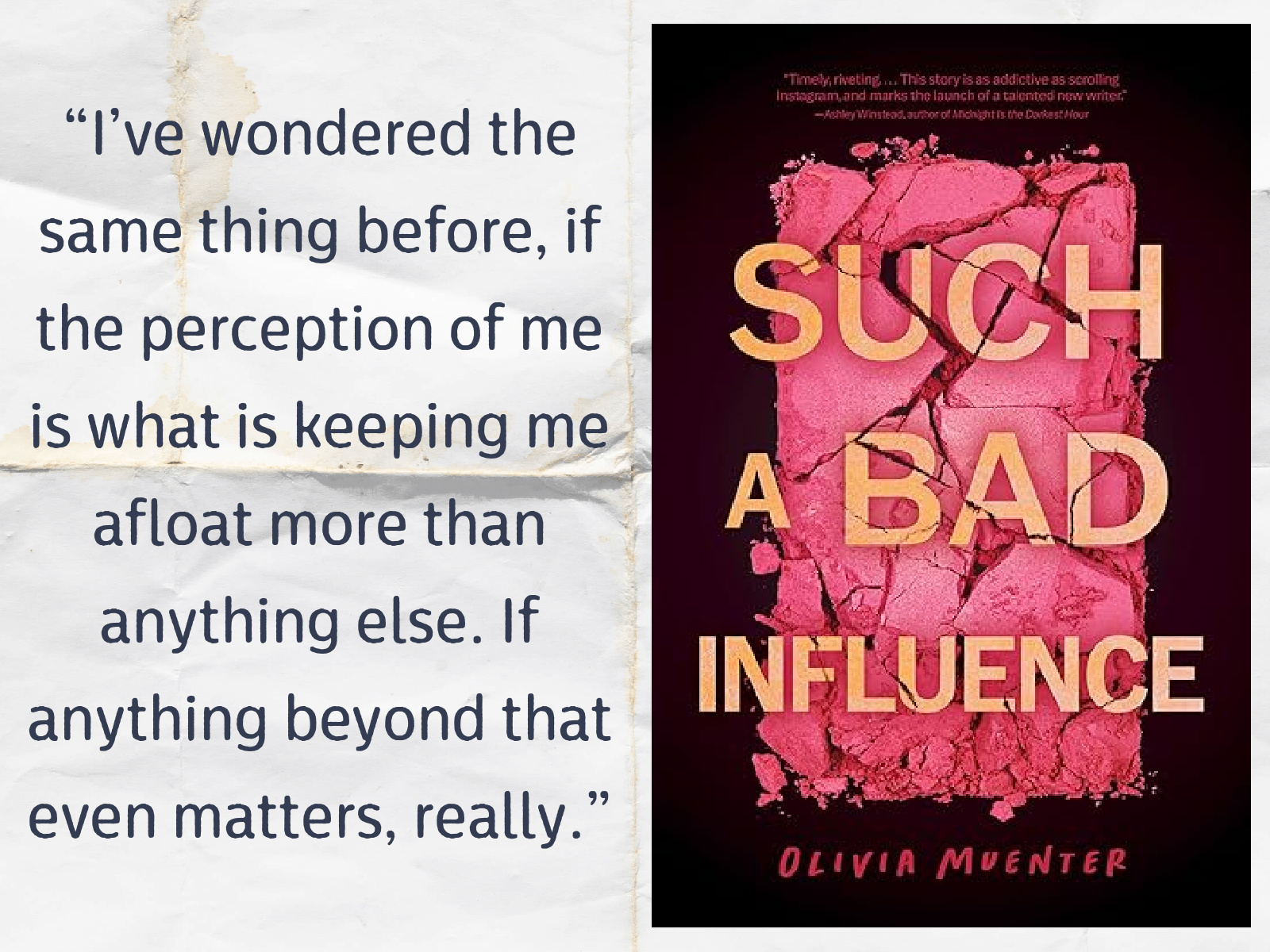
CHRISTMAS
Clarice Bean: Think Like an Elf, by Lauren Child—Clarice Bean loves Christmas and she’s disappointed that this year’s festivities will be kept to a minimum because Mom and Dad are too exhausted to go all-out for the holiday. Clarice decides she will do her part to spread Christmas cheer wherever and however she can—whether it’s making fudge for her friends and family, helping out at home (even when the “helping” goes awry), and offering assistance to neighbors (including the unfriendly ones). Despite all of Clarice’s best efforts at making it an “exceptionordinarily” great Christmas, it seems that everything is going wrong! The Christmas tree is too big for the living room, Cement the Dog has eaten the Christmas turkey, and all the Christmas packages have gotten mixed up. But with her positive attitude and creative problem solving, Clarice might be able to rescue Christmas and put some Christmas spirit back into the rest of the Tuesday family.
This book (curtesy of a librarian recommendation) was our family’s first introduction to Clarice Bean, and we were immediately smitten with this charming character and her quirky, stream-of-conscious narration. We loved the goofy humor (with plenty of over-the-kids’-heads jokes that adults will appreciate) and the full-color illustrations featuring drawings, collages, and creatively positioned photos.
The Christmas story being told here is very secular, and there are a few content issues (including the inclusion of an uncle’s live-in girlfriend and lots of environmental evangelism) that needed to be addressed and discussed. These issues aside, this is a charming story that made for a fun and memorable holiday read-aloud, and my kids can’t wait to read more from this series.
My Rating: 4.5 Stars (Rounded to 5 Stars on Goodreads) // Charleston’s Rating: 4.5 Stars // Sullivan’s Rating: 4.5 Stars // Kalinda’s Rating: 5 Stars // Book Format: Print
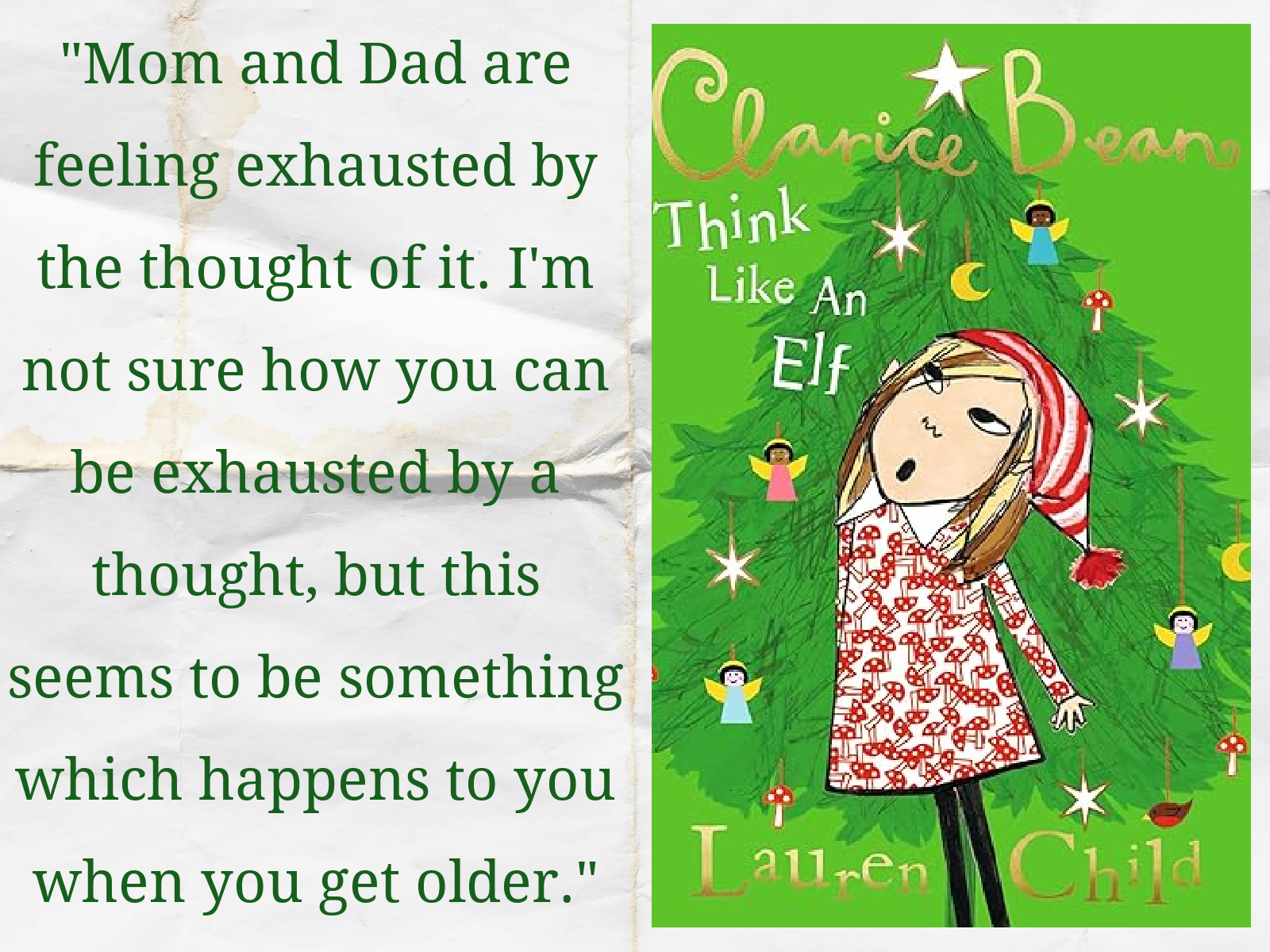
The Christmas House, by Beverly Lewis—Liz Lantz loves leading guided buggy tours for English tourists visiting her Amish community in Lancaster County. But the tours are a little different this year: Liz’s brother Adam, who has been called away for the season, is not able to accompany her on her daily routes, so their father has invited a young Amishman from another community to take Adam’s place. Liz soon warms to the handsome Matthew Yoder, but she is less taken with the lavishly decorated house that has been attracting unwanted traffic and attention to the community. Liz wants to express warmth and welcoming to the new neighbors who recently moved to the home, but she’s not quite sure how to make peace with these Englishers whose approach to life—and especially to Christmas—is so antithetical to her own.
Amish fiction is outside of my usual reading wheelhouse, and this book affirms that preference. To be fair, a Christmas novella might not be representative of the genre as a whole, so I probably shouldn’t rule out a future love affair with quaint Amish tales. But this one failed to draw me in, with characters and a story that lacked depth and random references to other characters that kept this from feeling like a standalone (though I don’t think it’s part of a series?). I did enjoy learning about Amish culture and their way of life, as Liz’s job as a tour guide to outsiders serves as a natural way of bringing the reader into this unfamiliar setting.
This felt like a Hallmark Christmas movie in book form, and though I almost always like the book more than the movie, I think I might prefer watching to reading this particular story.
My Rating: 3 Stars // Book Format: Kindle
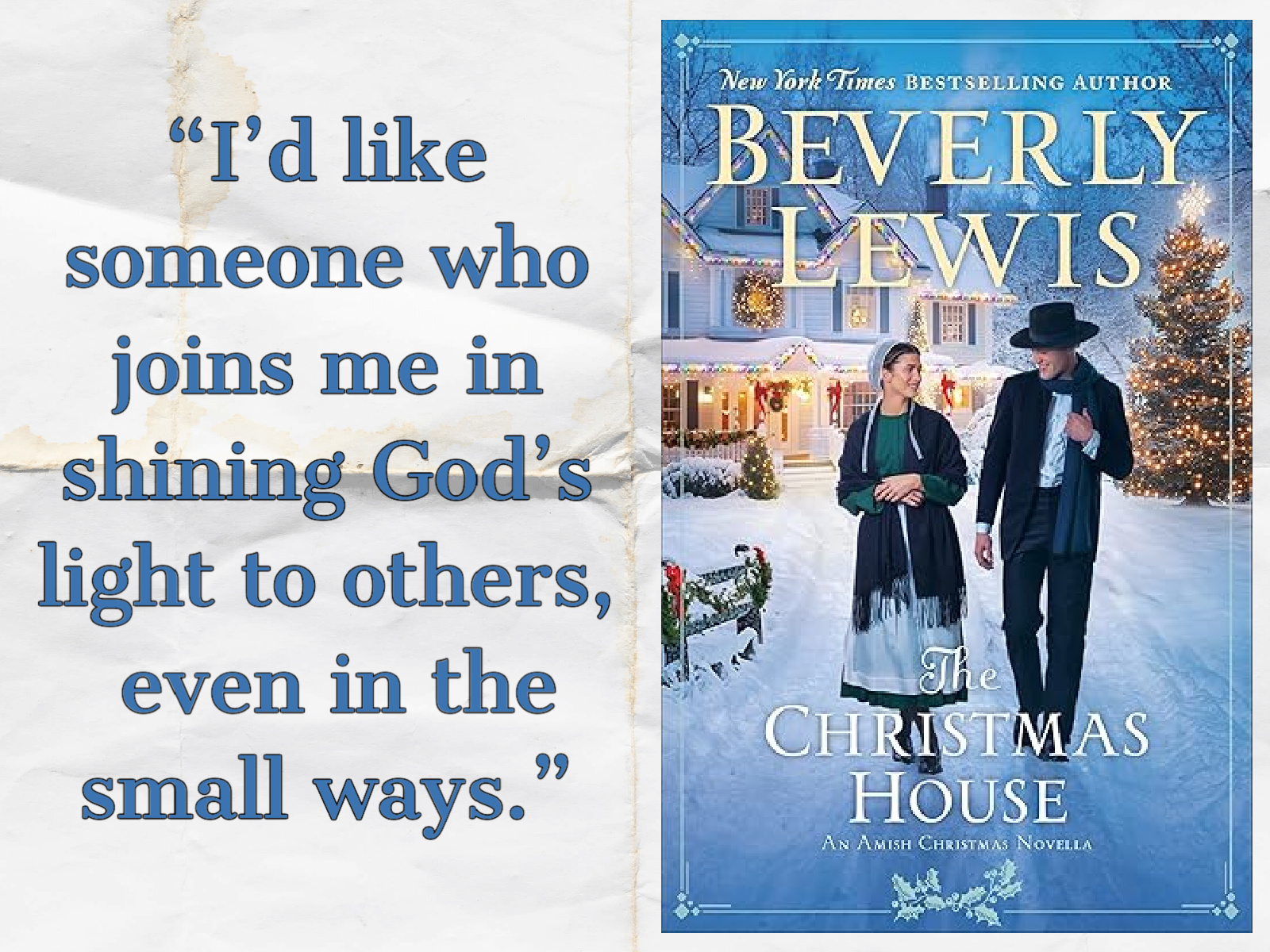
One Snowy Day, by Shari Low—On a snowy December day in the quaint Scottish village of Weirbridge, Jessie McLean is preparing for a grand party celebrating her 65th birthday and her well-deserved retirement after decades of styling hair. Tomorrow she and her husband are meant to board a plane for a new life of sun and leisure. But she’s not so sure she’s ready to leave behind the home, family, and friends she loves dearly. Jessie’s daughter Georgie is set to take over her mother’s hair salon, but she’s received an offer for the job of a lifetime—is she ready to turn it down?
Meanwhile, Alyssa Canavan receives news that she is being evicted from the café that is the heart of the village and Alyssa’s whole world. Her fate lies in the hands of Lachlan Morden, who has returned to his Scottish home to settle his late father’s affairs. Is Lachlan willing to set aside past grievances in order to pick up the pieces of another’s broken heart when his own remains shattered?
I really enjoyed this seasonal novel that follows the lives of our four protagonists across a single day. The setting is cozy and wintry (not explicitly Christmassy), and the characters are endearing if not especially memorable. I did struggle to get on board with a 38-year-old character grieving her empty nest (it’s possible but not at all relatable for this 41-year-old baby mama!), and I didn’t love the cavalier treatment of marriage and promiscuity. I also had a hard time keeping up with the extensive cast of characters (thank goodness for the opening page’s character list) and the many references to other storylines (this is a standalone, but as Low points out in her author’s note, some of her characters “like to pop up again and again in [her] world”). But I loved the sweet dynamic between the various female characters and the quaint portrayal of village life, and the story definitely goes down easy.
My Rating: 4 Stars // Book Format: Kindle

The Mistletoe Mystery, by Nita Prose—As a child, Molly Gray (head maid at the Regency Grand Hotel) always loved Christmas: she and her grandmother didn’t have much money, but Gran always filled the holiday season with fun traditions and abundant joy. Since Gran’s passing, Christmas hasn’t been quite the same, but this year Molly’s adoring boyfriend, Juan Manuel, is determined to make it a holiday that Molly will never forget. But when Juan begins acting mysteriously, Molly starts to questions his feelings for her. A Secret Santa gift exchange at the hotel will be the true test: can she trust those who claim to care for her, or is she destined once again to become the laughing stock of the hotel?
I didn’t care for The Maid, but am a sucker for a Christmas novella and decided to give this a shot. Unfortunately, this story is plagued by many of the same issues that kept me from loving the first in the series—most notably a predictable and uninteresting storyline (the mystery here is VERY thin), tedious callbacks to Gran’s many aphorisms, and the problematic treatment of Molly (a neurodivergent character, though this is never clearly stated) who is alternately mocked or infantilized by the other characters. This one does get a ratings boost for the heartwarming finale and for the Gift of the Magi tie-ins; but even though the end left me smiling, the novella as a whole solidified my disinterest in reading further in the series.
My Rating: 3 Stars // Book Format: Kindle
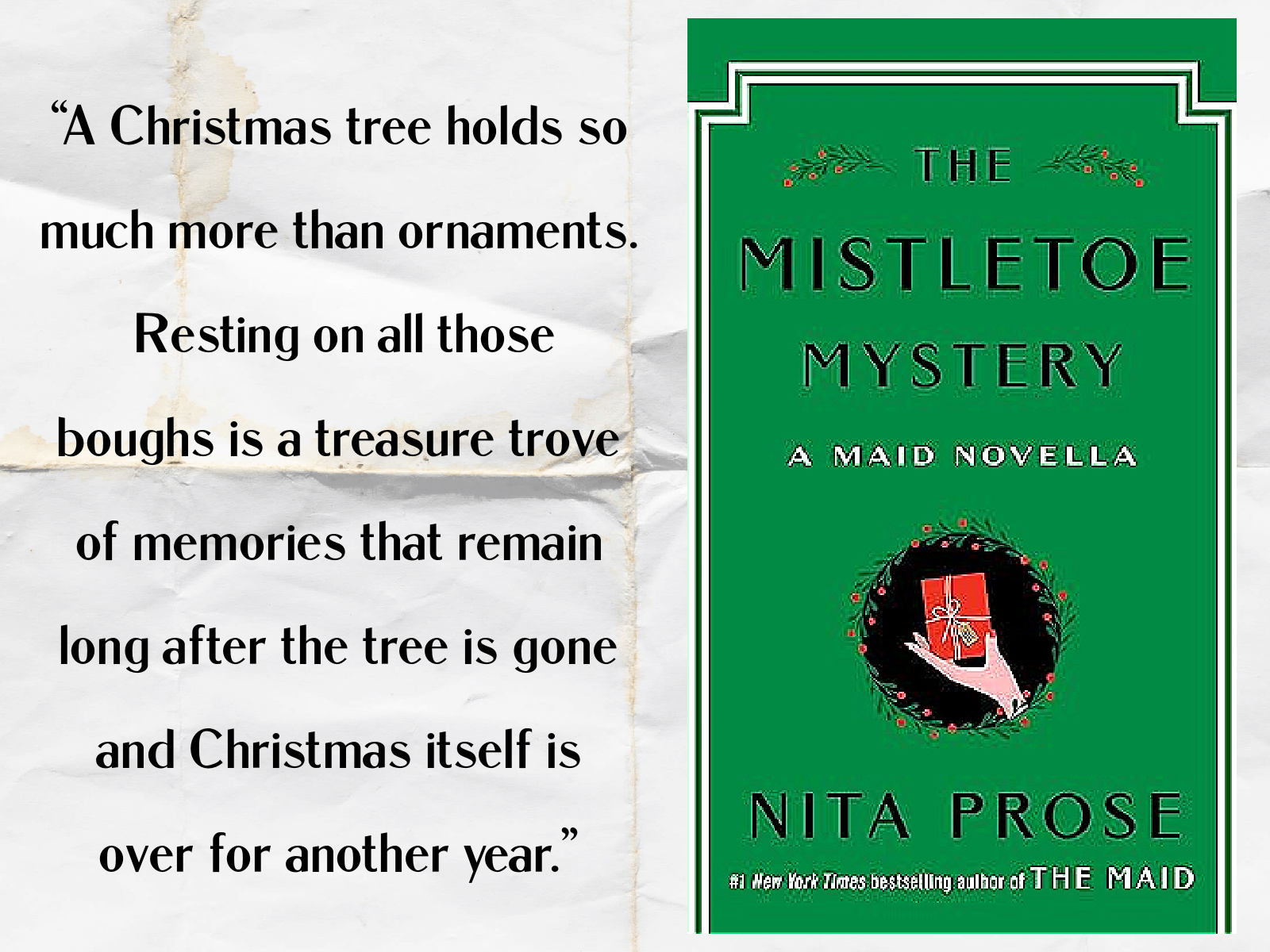
MIDDLE GRADE
Marjorie, by Sidney Baldwin—Marjorie is one of the independent novels for our 5th-grade Language Arts curriculum (from The Good and the Beautiful). Charleston really enjoyed this one and suggested I give it a read; I was happy to oblige! Below is the full review he wrote as a follow-up to his reading, followed by my own thoughts.
Have you ever wondered what it would be like to say good-bye to you mother, knowing you won’t see her or your sick father for months, knowing you’re about to spend the rest of your summer with your old nurse whom you barley remember and her awful husband on a horribly simple island? If so, you were wondering what Marjorie Jefferson was experiencing in Marjorie by Sidney Baldwin.
Set in 1950 (A.D.), the book follows the 11-year-old-girl (Marjorie, not Sidney Baldwin, who by the way is not 11) as she turns from spoiled city girl to kindhearted islander.
I enjoyed Marjorie and think it has many good examples of compassion, such as when Marjorie sees Jock’s worn feet and kindly knits him a pair of socks. I also liked the entertaining format, with chapter-long short stories that eventually wrapped up into one big story.
I suggest the book to all who like short, uplifting, and above all moralizing tales.
Kendra Note: Honestly, this wasn’t my favorite. The familiar premise of “spoiled city girl softened by kind island folk” is endearing, but the writing here is mediocre at best, with sloppy prose, pedantic moralizing, and a story that is far too tidy. Like Charleston, I enjoyed the sweet lessons but felt their packaging could have been more polished. That said, it’s tough to truly dislike a values-forward book (and an assigned one at that!) that my kid loved, so good job to The Good and the Beautiful for continuing to expose our family to content that is educational, entertaining, and in line with our family values.
My Rating: 3 Stars // Charleston’s Rating: 4 Stars // Book Format: Print
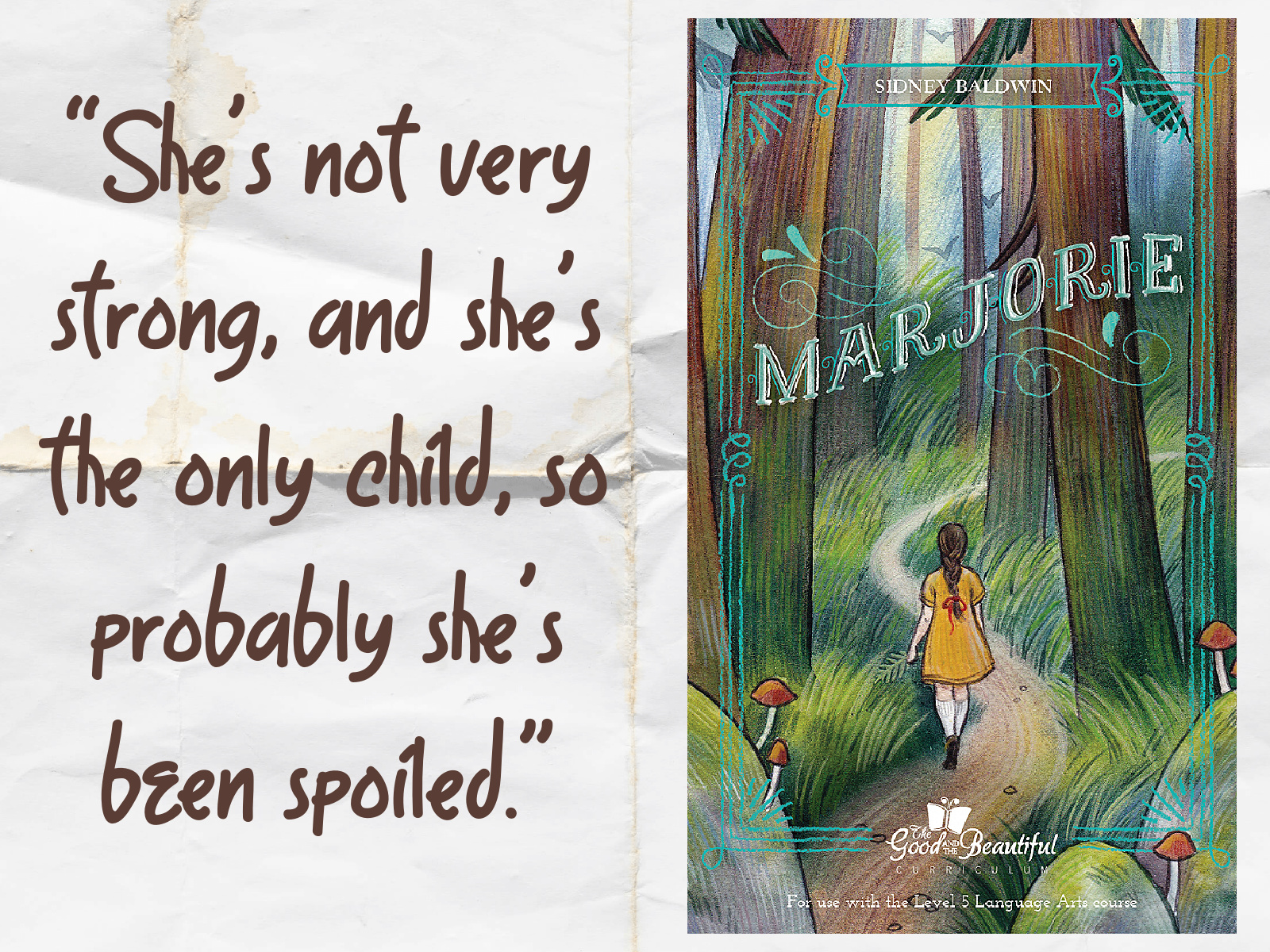
Cheaper by the Dozen, by Frank Gilbreth, Jr.—We read this one aloud as a family. Below is a book review written mostly by Charleston, with contributions from the rest of our family and a follow-up frome me.
Do you think you have a large family? Do you have far too many brothers and sisters to cope with, and any minute someone will start crying and everything will fall to pieces in chaos? If you have any fewer than eleven siblings, then you have it pretty easy compared to the Gilbreths. Perhaps the way they manage is that stuff comes cheaper by the dozen.
When efficiency experts Mr. and Mrs. Gilbreth first got married, they decided to go for an even dozen children. And when the first one came, they just wouldn’t stop coming. After about twenty years, all the excitement is over and the last baby has been born. For dad and the kids, it’s now time to have some fun, be the most efficient people on earth, and become the first-ever family to function like a fine-tuned business.
In this true and very humorous story, Frank Gilbreth, Jr., (one of the Gilbreth’s dozen kids) shares stories of growing up as the son of the meticulous and stubborn—yet lovable and funny—Frank Gilbreth. Each chapter tells another anecdote from the family’s unique experience of life in the 1920s.
Kali really liked this book. Her favorite part was when the older girls were trying to wear new outfits and their dad wasn’t happy about it. Sully liked reading about the things the kids did with their dad, liking going to the movie theater. Kali and Sully both thought it was funny how the kids tricked a woman testing their intelligence by giving surprising responses. Nico liked listening in, playing and eating cheerios while he heard Mom read about other kids his age.
When it comes to my personal reading, I (Charleston) prefer books with one plot as opposed to many short stories, but I liked this as a family read-aloud since it was easier to keep up with what was happening. I was sad to read that Frank Gilbreth died while some of his children were still young and the oldest was just in college. Though I have my preference for bigger plots, I’m curious how the next book (which I plans to read independently) will turn out; I’m eager to read about the Gilbreth’s family adventures after Dad’s passing. I recommends this book to people who enjoy learning about families from the past (especially how different things were in the 1920s) or who like funny, family-friendly stories.
Kendra Note: This was my favorite read-aloud of the year! I loved the jaunty tone and warm family vibes. It worked great as a read-aloud with our family who feels big but is NOTHING compared with the Gilbreths, and we all enjoyed hearing about what it might be like to have even more kids in the family. The efficiency experiments and protocols were fascinating, and I was intrigued by the insights into American life in the early 1900s. I like seeing inspiring mother figures in my reading, and Lillian—who is patient with her many children and zany husband, yet firm where it matters—is an excellent mothering role model.
A note on some content issues: some of the themes and language are a little mature for young readers; I modified or skipped these portions as we read aloud.
Mom’s Rating: 5 Stars // Charleston’s Rating: 4.5 Stars // Kalinda’s Rating: 4.5 Stars // Sullivan’s Rating: 4.5 Stars // Book Format: Print
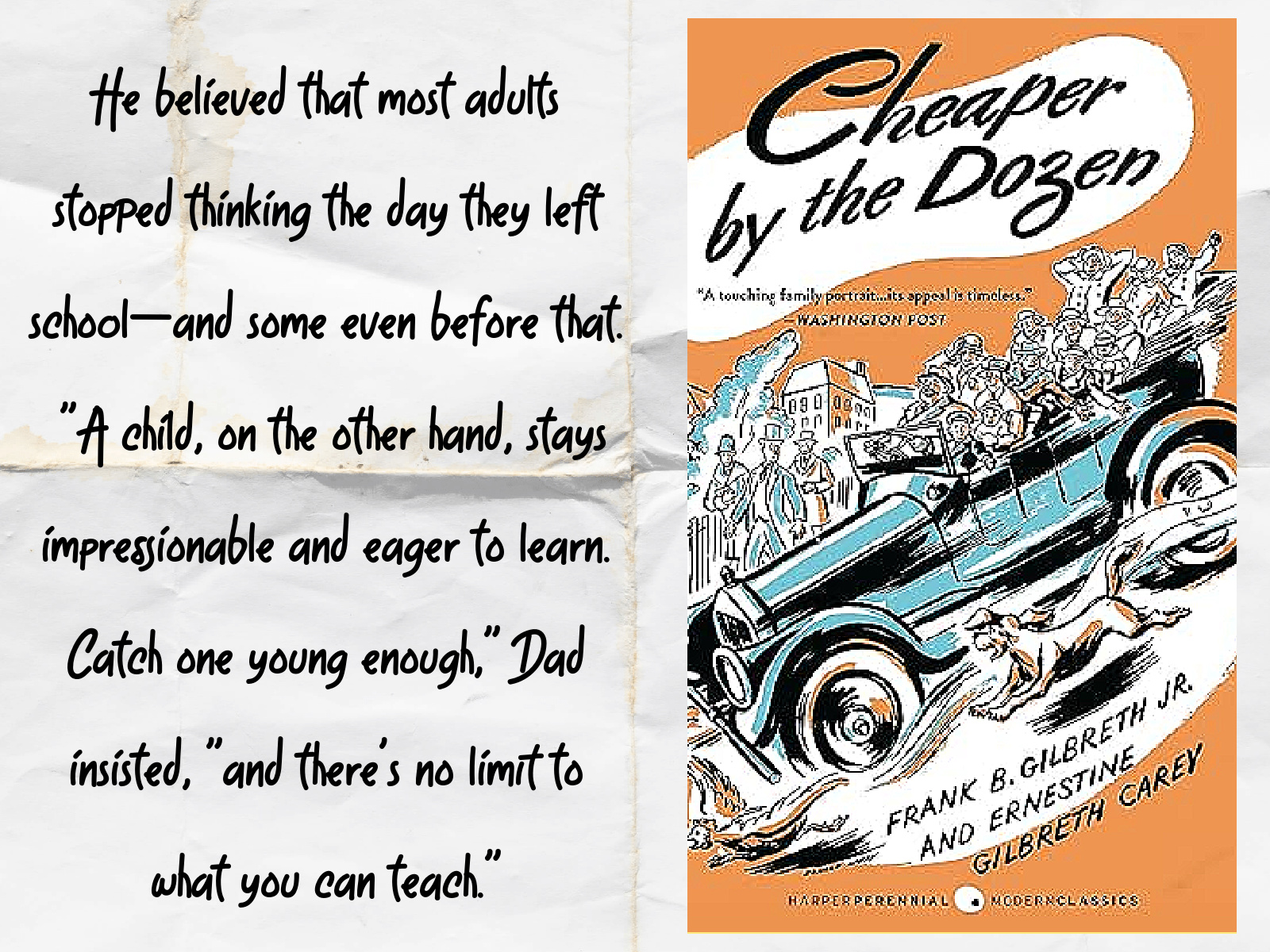
Elizabeth I: Red Rose of the House of Tudor, England, 1544, by Kathryn Lasky—Our history curriculum recently covered Henry VIII and his children. I knew very little about the House of Tudor prior to this History unit, but the lesson ignited a thirst for more information about this fascinating historical family. A Libby search on the subject led me to this book; only after I’d begun listening did I realize that this was written for a Middle Grade audience (and that it’s part of a series!), but it was EXACTLY the book I needed to scratch the monarch-sized itch in my reading life.
The book covers Elizabeth’s preteen years, as told through the princess’s fictional diaries. Elizabeth recounts her lonely upbringing as a child whose mother and several stepmothers were done away with—all at the hands of her father, yet Elizabeth is willing to overlook his many flaws and remains desperate for his attention. Through her diaries, we get a glimpse into royal life in 16th-century England—the holidays, educational methods, and unsavory medical practices. We also witness the various scandals and intrigue surrounding Elizabeth and her family, from her older sister Mary’s presumed insanity to the rivalry between Elizabeth and her cousin, Lady Jane Grey.
Though the book doesn’t cover every detail of this historical figure, it provides an excellent introduction to the time period and to Elizabeth herself, giving a thorough but age-appropriate overview of the lives of Elizabeth and the rest of the Tudor family. Kathryn Lansky does an excellent job bringing the Tudor world to life in a way that will feel both intriguing and accessible to young readers and was even riveting to me as an adult who just happens to have a thing for Middle Grade historical fiction. I was particularly impressed with Lansky’s ability to capture Elizabeth’s personality, as well as many hints as to what is to come in the life of this future queen. What a delightful way to consume history; I only wish I had gotten to read this series as a young girl, and I will be recommending it to my daughter when she gets a little older.
My Rating: 4.5 Stars (Rounded to 4 Stars on Goodreads) // Book Format: Audiobook

NONFICTION
Listening to Your Life: Daily Meditations, by Frederick Buechner—I like to read through a daily devotional each year, and this was my choice for 2025. The book comprises daily meditations taken from Buechner’s novels, memoirs, essays, teachings, and various nonfiction titles. It’s an excellent introduction to the work of this prolific writer and thoughtful Christian, and I was impressed with the breadth of subject matter, lovely prose, theologically rich content, and insightful applications. I’m not sure I align with all of Buechner’s theology that trends somewhat towards the mystical, but I value his observations on the Christian life, human nature, meditation, and the art of storytelling.
While the content is golden, the book’s structure keeps it from being a five-star devotional. I wanted more cohesiveness between the daily mediations that are randomly placed and (seemingly) haphazardly selected from various sources. These sources are listed in an appendix at the back of the book, and I referred to this index often when making notes on which of Buechner’s titles I may want to read in fully, but it would have been helpful to have each devotional’s book source listed next to the date.
I can imagine that this would be most fully appreciated by long-time fans of Buechner’s writing (especially his fiction), but even as one who was new to his work, I found this to be a rewarding and thought-provoking companion through this year.
My Rating: 4.5 Stars (Rounded to 5 Stars on Goodreads) // Book Format: Kindle
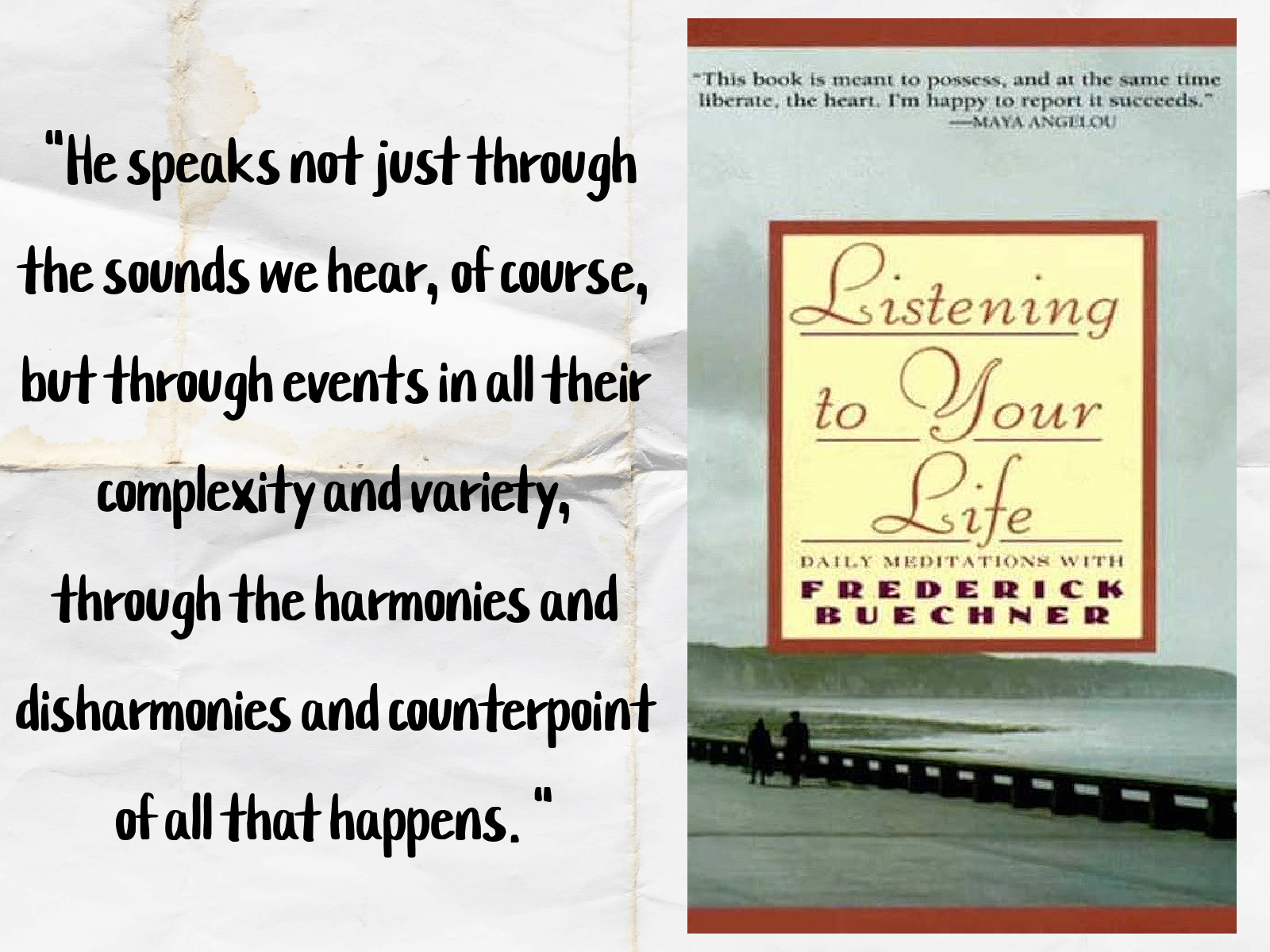
Here Be Dragons: Treading the Deep Waters of Motherhood, Mean Girls, and Generational Trauma, by Melanie Shankle—Melanie Shankle’s daughter Caroline had always had an easy time with friends, so it came as a surprise to both mother and daughter when Caroline’s high school peers suddenly turned on her, determined to make Caroline’s sophomore year a miserable one. Watching her daughter wage counterattacks against these adolescent dragons, Melanie soon realized that this wasn’t her first time encountering mean girls. But the real mean girl in Melanie’s life wasn’t a peer; it was her own mother.
In Here Be Dragons, Melanie candidly shares what it was like to grow up in the home of a mentally ill mother who was malicious and manipulative towards her daughters. Their mother/daughter dynamic was an unhealthy one that Melanie never fully recognized or understood until adulthood, and it set Melanie up for significant challenges as she navigated friendship, dating, marriage, and eventually motherhood. Once aware of her family’s disfunction, Melanie grew determined to heal her generational wounds and conscientiously break patterns of generational abuse for her sake and that of her daughter.
Like all of Melanie’s books, this one is filled with relatable storytelling and self-effacing humor that brings much-needed levity to a difficult topic. I love Melanie’s writing style, and I really appreciated her thoughts on motherhood and the challenges of raising a child who is living into her God-given gifts and potential. Even though I don’t (yet) have a teenage girl myself, I could relate to Melanie’s experiences of relinquishing control over her daughter’s personality and skills and entrusting her child’s future to God. Even though the details of Caroline’s mean-girl experiences terrified me, I find it valuable to read ahead about what might be in store for our family in the coming years, and Melanie’s God-centered approach to the teen years is an excellent model for how I hope to navigate those stages.
This book is really two in one, with the latter half focused on parenthood and the first half centered around Melanie’s relationship with her mom. I had a harder part with this first section that felt like a long-form defense of Melanie’s decision to cut off all contact with her mother as an adult. As an outsider, it does seem that this was a necessary decision in Melanie’s situation, but while many may find peace and clarity in seeing their own stories reflected in Melanie’s situation, I worry that some readers may accept Melanie’s experience as a permission slip to distance themselves from individuals in their own lives, and I don’t know that this is always the healthiest approach. I also have to admit that it was hard to read about the poor behavior of a woman (Melanie’s mom) who is no longer alive to offer her own version of events. I always feel conflicted with memoirs that expose others’ misbehavior, especially when those memoirs are written by Christians. I can understand that writing such a memoir could be cathartic for the writer and useful for the right audience, but reading these sort of exposés always leaves me feeling a little unsettled.
Misgivings aside, I’m glad that I read this (I always knew that I would, since I’m a Melanie Shankle completist!). Melanie brings light, healing, and Biblical perspective to a topic that is too prevalent in mothers and daughters and in female friendships, and I hope that her work has resulted in healing for her many readers and followers. I know that her words have me reflecting deeply on how I show up for my own kids; it has inspired me to parent them from a healthier, whole place that always points them back to the Lord who is the only perfect parent in their lives and who can bring beauty from chaos and ashes.
My Rating: 4 Stars // Book Format: Kindle

Come On Home: A Grace-Filled Guide to Raising a Family Who Loves (and Likes) Each Other, by Jessica Smartt—I’m always up for a little parenting refresher in book form, and I was thrilled to jump into this one from a homeschooling mama whose work I’ve followed for quite a while—especially since the theme of raising a strong family is close to my heart. In Come on Home, Jessica relies on her personal experience (within her family of origin as well as her current family with her husband and children) to guide parents in creating strong families.
According to Smartt, a strong family begins with a foundation of honesty, perspective, authority, partnership, and prayer. Once these family needs are in place, families can grow through planted seeds of time, connection, memories, and other pivotal components. Smartt explores each of these foundational characteristics, offering practical ideas for applying them in the home and sharing interviews from various strong families who embody these qualities.
This was such a great read! While the subject may seem aspirational, Smartt’s gracious approach makes having a strong family seem totally attainable. Smartt is transparent about her own shortcomings while also inspiring parents to move beyond our personal insecurities and limitations to create warm, welcoming, Christ-centered families who are known for loyalty, connection, and grace. I loved the mix of story and Biblical insight, and I found the bulleted ideas at the end of each chapter extremely helpful.
In her opening chapter, Smartt reminds readers why having a strong family is so important: it tethers kids to something solid in a changing world, gives kids friends who are truly behind them, provides them with memories to draw from in difficult times, gives them a soft place to land, makes theology come alive for them, provides the building blocks for a healthy society, and establishes a legacy. What a wonderful goal, and one that Smartt has done a excellent job of helping parents achieve.
My Rating: 4 Stars // Book Format: Audiobook
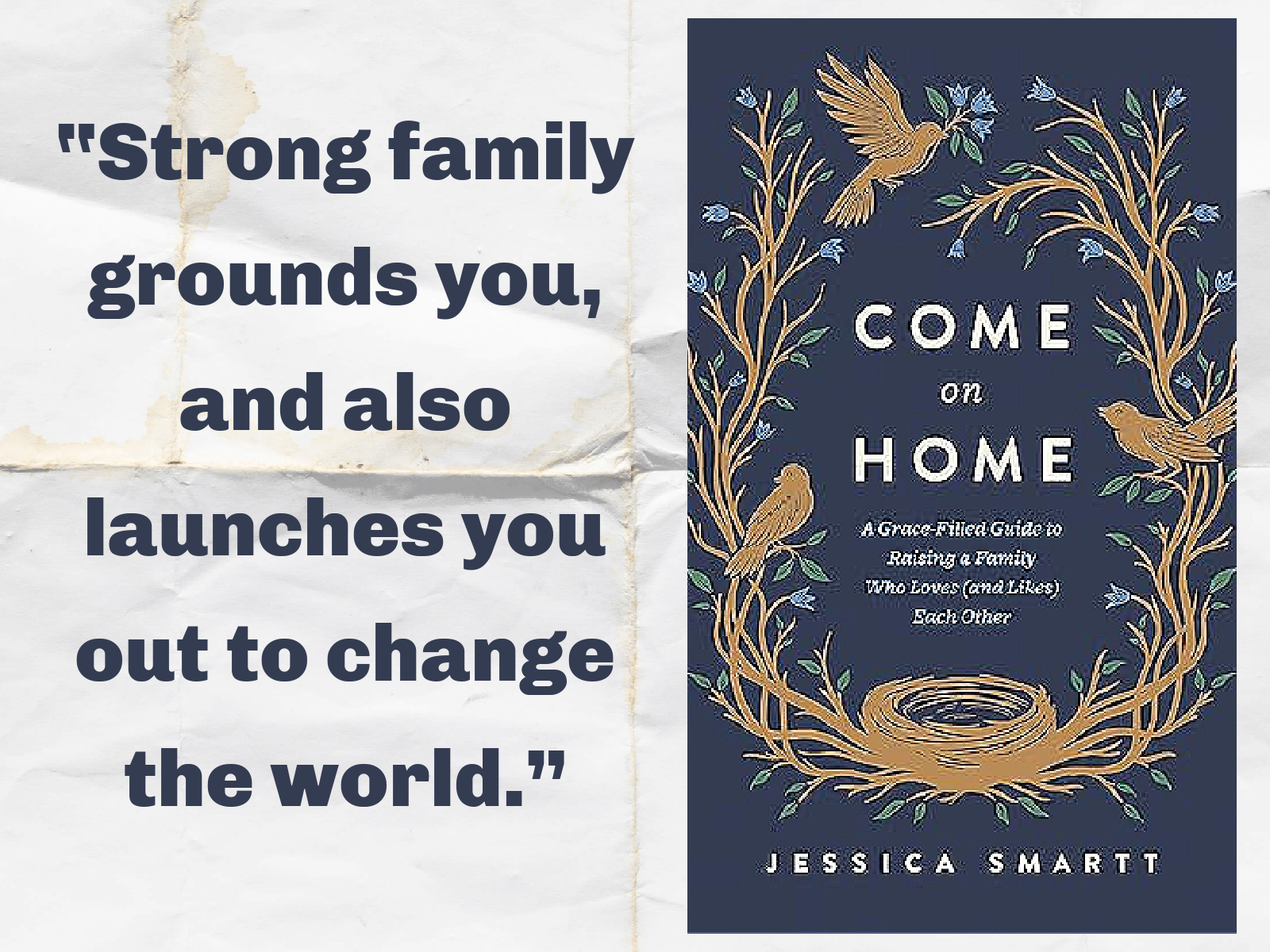
What have YOU been reading lately? I’d love to hear about your latest reading successes (and flops!).
